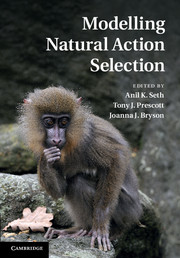Book contents
- Frontmatter
- Contents
- Foreword
- Preface
- Contributors
- 1 General introduction
- Part I Rational and optimal decision making
- Part II Computational neuroscience models
- Part III Action selection in social contexts
- 18 Introduction to Part III: action selection in social contexts
- 19 Agent-based models as scientific methodology: a case study analysing the DomWorld theory of primate social structure and female dominance
- 20 An agent-based model of group decision making in baboons
- 21 Endogenous birth and death of political parties in dynamic party competition
- 22 On optimal decision making in brains and social insect colonies
- 23 State-dependent foraging rules for social animals in selfish herds
- Index
- Plate section
- References
19 - Agent-based models as scientific methodology: a case study analysing the DomWorld theory of primate social structure and female dominance
from Part III - Action selection in social contexts
Published online by Cambridge University Press: 05 November 2011
- Frontmatter
- Contents
- Foreword
- Preface
- Contributors
- 1 General introduction
- Part I Rational and optimal decision making
- Part II Computational neuroscience models
- Part III Action selection in social contexts
- 18 Introduction to Part III: action selection in social contexts
- 19 Agent-based models as scientific methodology: a case study analysing the DomWorld theory of primate social structure and female dominance
- 20 An agent-based model of group decision making in baboons
- 21 Endogenous birth and death of political parties in dynamic party competition
- 22 On optimal decision making in brains and social insect colonies
- 23 State-dependent foraging rules for social animals in selfish herds
- Index
- Plate section
- References
Summary
Summary
A scientific methodology must provide two things: first a means of explanation, and second, a mechanism for improving that explanation. It is also advantageous if a methodology facilitates communication between scientists. Agent-based modelling (ABM) is a method for exploring the collective effects of individual action selection. The explanatory force of the model is the extent to which an observed meta-level phenomena can be accounted for by the behaviour of its micro-level actors. But to demonstrate ABM is truly a scientific method, we must demonstrate that the theory it embodies can be verified, falsified, extended, and corrected. This chapter contains a case study demonstrating ABM as biological science. We show that agent-based models like any scientific hypotheses can be tested, critiqued, generalised, or specified. After first reviewing the state of the art for ABM as a methodology, we present our case: an analysis of Hemelrijk's DomWorld, a widely published model of primate social behaviour. Our analysis shows some significant discrepancies between the model and the behaviour of the genus we compare it to, the macaques. We then demonstrate that the explanation embodied in the DomWorld model is not fragile: its other results are still valid and can be extended to compensate for the problems identified. This robustness is a significant advantage of experiment-based artificial intelligence modelling techniques over purely analytic modelling.
Introduction
Agent-based modelling (ABM) is a method for testing the collective effects of individual action selection. More generally, ABM allows the examination of macro-level effects from micro-level behaviour. Science requires understanding how an observed characteristic of a system (e.g., a solid) can be accounted for by its components (e.g., molecules). In ABM we build models of both the components and the environment in which they exist, and then observe whether the overall system-level behaviour of the model matches that of the target (or subject) system.
- Type
- Chapter
- Information
- Modelling Natural Action Selection , pp. 427 - 453Publisher: Cambridge University PressPrint publication year: 2011



